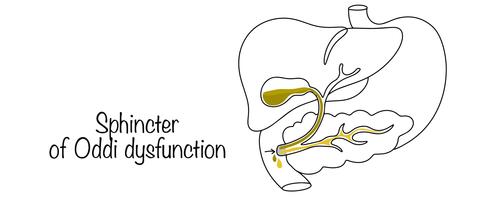Endoscopic sphincterotomy for sphincter of Oddi dysfunction
Coté GA, Gut. 2024;74(1):58-66
In this prospective cohort study, approx. 60% of patients with suspected sphincter of Oddi dysfunction experienced a subjective improvement in symptoms following endoscopic sphincterotomy, although the placebo response rate remains unknown. Clinical factors including the diameter of the pancreatic duct or pancreatic laboratory tests prior to the intervention did not influence the response rate. The risk of pancreatitis recurrence within 1 year remained high in patients with a history of idiopathic pancreatitis.
Objective: Sphincter of Oddi disorders (SOD) are contentious conditions in patients whose abdominal pain, idiopathic acute pancreatitis (iAP) might arise from pressurisation at the sphincter of Oddi. The present study aimed to measure the benefit of sphincterotomy for suspected SOD

Design: Prospective cohort conducted at 14 US centres with 12 months follow-up. Patients undergoing first-time endoscopic retrograde cholangiopancreatography (ERCP) with sphincterotomy for suspected SOD were eligible: pancreatobiliary-type pain with or without iAP. The primary outcome was defined as the composite of improvement by Patient Global Impression of Change (PGIC), no new or increased opioids and no repeat intervention. Missing data were addressed by hierarchal, multiple imputation scheme.
Results: Of 316 screened, 213 were enrolled with 190 (89.2%) of these having a dilated bile duct, abnormal labs, iAP or some combination. By imputation, an average of 122 of 213 (57.4% [95% confidence interval: 50.4–64.4%]) improved; response rate was similar for those with complete follow-up (99/161, 61.5% [54.0–69.0%]); of these, 118 (73.3%) improved by PGIC alone. Duct size, elevated labs and patient characteristics were not associated with response. AP occurred in 37 of 213 (17.4%) at a median of 6 months post ERCP and was more likely in those with a history of AP (30.9% vs. 2.9%, p < 0.0001).
Conclusion: Nearly 60% of patients undergoing endoscopic retrograde cholangiopancreatography for suspected sphincter of Oddi disorders improve, although the contribution of a placebo response is unknown. Contrary to prevailing belief, duct size and labs are poor response predictors. Acute pancreatitis (AP) recurrence was common and like observations from prior non-intervention cohorts, suggesting no benefit of sphincterotomy in mitigating future AP episodes.